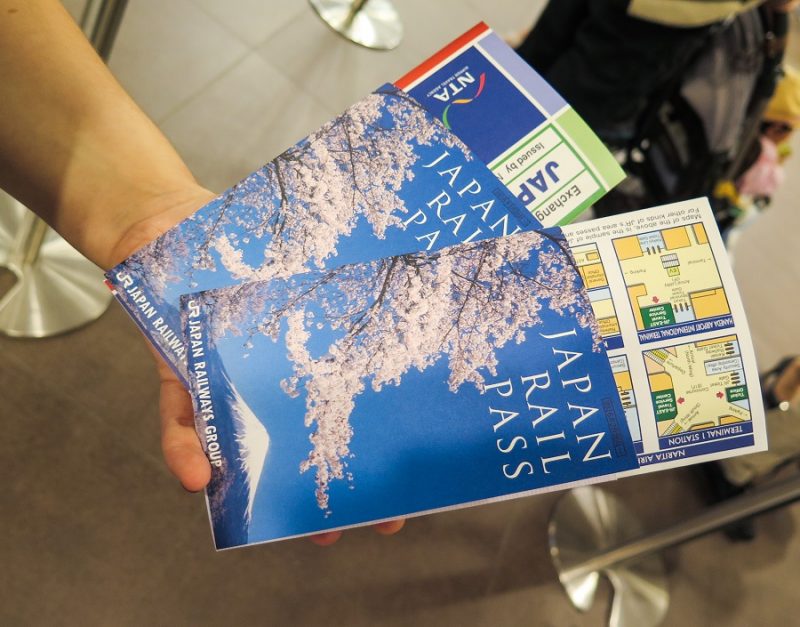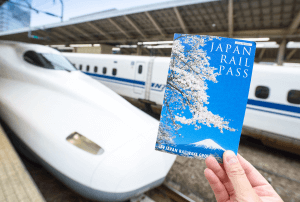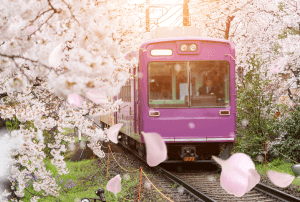Japanese trains are famed for being fast, punctual, and comfortable, and there are a wide variety of ticket options.
Japan train tickets can be bought from touch-screen machines at all major train stations using credit or debit cards. The vast majority can be read in English, and they are fairly simple to use.
The Japan Rail Pass is a great option for tourists traveling extensively around the country. You can order the pass online before you travel, and use it on all JR lines, buses, ferries, and airport transfers.
Find out more about Japan’s train ticket options here.
Table of Contents
Single train tickets
The overall cost of single train tickets in Japan is made up of various fees. This includes the base cost, which is roughly ¥20 per km for short distances and under ¥10 per km for long distances.
You can reserve a seat for an additional fee, which varies depending on whether it is the high or low season. Seat reservations can be made as early as a month before the departure date.
Fees also vary depending on the type of train (Express, Limited Express etc.), and there is a Green Car Fee if you sit in the first-class section.
|
Japan train tickets cost |
||
|---|---|---|
| Base Fare | ¥20/Km (short distances) | ¥10/Km (long distances) |
| + Supplement Fees: Train type | Min. price | Max. price |
| Limited Express Fee (Shinkansen) | ¥800 | ¥8.000 |
| Limited Express Fee (Limited Express trains) | ¥500 | ¥4.000 |
| Express Fee | ¥500 | ¥1.500 |
| + Supplement Fees: Extras | Min. price | Max. price |
| Green Car Fee | ¥700 | ¥7.500 |
| Seat Reservation Fee | ¥200 | ¥520 |
| Night Train Berth Fee | ¥6.500 | ¥14.000 |
| No travel | Min. price | Max. price |
| Entering the Station Fee | ¥120 | ¥170 |
Shinkansen Tickets
There are 2 classes of seats on most Shinkansen trains: ‘Standard’ and ‘Green’. ‘Standard’ seats are comfortable and offer spacious legroom. ‘Green’ seats are the first-class option, they are even more spacious and the cars are less crowded.
Most Shinkansen offer reserved and non-reserved seats. Seat reservations are on certain types of trains on some lines (Hayabusa, Hayate, and Komachi trains on the Tohoku and Hokkaido Shinkansen lines, and the Kagayaki trains on the Hokuriku Shinkansen line). All Green car seats are also always reserved.

Shinkansen tickets include an additional fee, which increases according to the journey distance.
There is also a seat reservation fee which is ¥320, ¥520 or ¥720 depending on whether it is the high, low, or regular season. An additional fee of between ¥100 and ¥620 is charged for reserving seats on Nozomi, Mizuho, Hayabusa, and Komachi trains.
Where to buy train tickets
Single tickets for trains can be purchased in different ways. Firstly, passengers can buy them from any of the ticket offices at stations across Japan. There are also vending machines at stations which allow people to make seat reservations.
e-tickets can also be bought online through each individual train operators’ website, using just your mobile phone. Key ticket providers include Ekinet for JR East and SmartEX for Tokaido, Sanyo, and Kyushu Shinkansen.
Some sites are in Japanese, but JR Group has a user-friendly, English version of their websites where you can easily buy tickets and reserve seats.
JR Pass: Nationwide rail pass
To avoid buying multiple separate tickets, you can buy a nationwide rail ticket which allows you to travel to multiple places with the same ticket.

On most services, passengers with a JR Pass do not need to pay individual train fares, supplement fees, or reservation fees. The JR Pass offers unlimited access to all JR trains, including Shinkansen bullet trains (including Nozomi and Mizuho trains by paying a supplemental charge), limited express trains, local trains, buses, ferries, and airport transfers.
The JR Pass can be bought as a 7, 14 or 21-day pass, either as a “Standard” or “Green” (first-class) pass. They have to be ordered online, in advance of the trip. Visitors receive an ‘Exchange Order’ which they can present on arrival to receive their JR Pass.
The pass is only available to foreign visitors.


The JR Pass gives you unlimited access to transportation all around Japan for 7, 14, or 21 days, including Shinkansen.
A single ticket, huge savings.
Regional train tickets
If you plan on exploring a particular region of Japan, you have the option of buying a regional rail pass which offers unlimited travel within a single region.
Regional passes are an efficient way of traveling around a specific part of the country. However, if you plan on traveling to between multiple regions, it is normally more worthwhile to buy a JR Pass.
The passes differ in price and are run by different operators. There are passes available for various regions including Kyushu, Shikoku, and Kansai. JR East and JR West also offer specific passes (for eastern and western Japan). There are also more tailored passes such as the Hokuriku Arch Pass, which lets you go from Osaka to Tokyo passing through Kanazawa and Kyoto.


If you're looking to extensively explore a specific area of Japan, choose one of the JR Regional Passes for unlimited travel within a designated region.
City passes
You can also buy passes for specific cities which offer unlimited travel on subways, trains, trams, and buses for limited periods of time. In each city, there are normally various options available.
For example, in Tokyo alone, there is the Tokyo Free Kippu (unlimited use of metro lines and trains), the Tokyo Subway Ticket (unlimited metro), Toei One-Day Pass (unlimited use of the four Toei subway lines), and various other combination tickets.
Prepaid IC cards
IC cards are a convenient way of paying fares on public transportation. You can top-up your card and then pay just by touching it on a reader for just a second. There are more than 20 train and bus operators included in the scheme and you can also use IC cards for various other things, such as vending machines.

Using IC cards offers discounted prices on tickets too and works out as much cheaper than individual tickets. For more detailed information, read our article about Japanese IC Cards.
